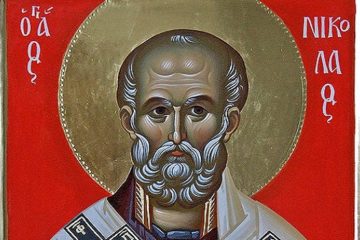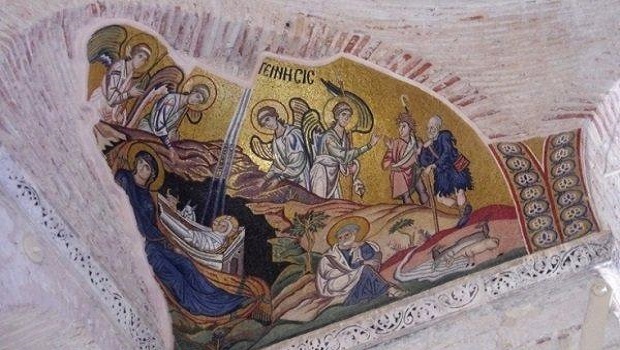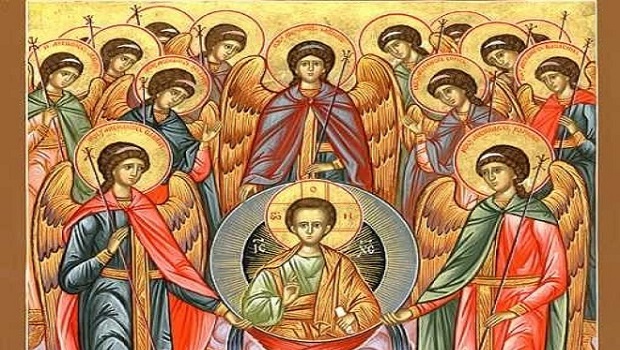Protopresbyter Nikolaos Patsalos
After the middle of this period [Lent], then, the Church provides appropriate additional help in our ascetic efforts, which differ in accordance with the capacities of each one of us, by presenting the perfect figure of asceticism, Saint John of the Ladder, that great asceticwho really did shed blood through his spiritual struggles in order to receive God the Holy Spirit. The whole of the striving which brought him to God is described by him in his work ‘The Ladder’, a book which, for monastics, is the surest road-map for their way of life. Of course, the Church recognizes our human weakness, but doesn’t make any concessions to it. It continues to set the bar high, showing us what’s perfect, so that we will continue to try for what’s better. It’s too difficult ‘in one day and hour’, or even over the course of the forty-odd days of Great Lent, to achieve the spiritual stature of Saint John the Sinaite. But realizing this can only teach us that we need a continuous struggle in order to sacrifice our egotism.
The life of Saint John of the Ladder provides us with a valuable coffer of wisdom on how to live these blessed days of Lent. If we feel tired, in difficulties, pressurized by our spiritual efforts (the fasting, prayers and so on) then we’re doing something wrong. This is where Saint John comes in, showing us how forcefully and intently we should turn to God so that our struggle becomes easier. In his ‘Ladder’ he says we should turn to God with ‘erotic’ love, that is, in the way that a person in love regards the object of his or her affections. How the other person is constantly in their thoughts. This, he says, is how we should love God. Divine love is turning to Him madly and giving our very being into His love.
Along the same lines, the modern representative of Saint John of the Ladder, Saint Porfyrios Kavsokalyvitis [i.e. who lived at Kavsokalyvia, on Mount Athos] confessed that there’s another, easier path to God and a way to avoid the cunning snares of the devil, and this is erotic love for God. This is expressed in the continuous remembrance of Christ, in our heart and mind, and even when the body’s engaged in other tasks. This road, he says, ‘involves being in love with Christ and longing for Him’. And in your desire to give yourself to God, you’re helped by all the means the Church places at your disposal: fasting, asceticism, participation in the sacraments, hymnology, lives of the saints, services, the Jesus Prayer, and so much else, formal or spontaneous, that we can do, provided we do so out of longing, not coercion.
Saint Porfyrios really is today’s great teacher, because he understands our complacent mind-set, which makes it difficult for us to see God. He taught that there are two paths to God: one is hard and tiring, with fierce attacks against evil, and the other is smoother and easier. The first describes the great saintly and ascetic warriors, such as John of the Ladder and Saint Paisios the Athonite. The second, easier way is simply to give yourself over to the love of God and not to fight evil directly. You don’t attempt to disperse the darkness from the chamber of your soul, you just make a little hole for the light to come in. You don’t fight the enemy, you disdain him and embrace Christ in a variety of ways. Saint Porfyrios also says that this is what he managed to do by intense devotion to the hymns and books of the Church and the Lives of the Saints, all of which moved him greatly and inspired him.
So, as Fr. Alexander Schmemann said, let’s take Great Lent seriously and immerse ourselves willingly in the weekly services. During the time that remains, let’s live ‘in prayer and fasting’. With burning love and devotion, not coercion. Lent shouldn’t be a formal affair but a necessity of life. It should be natural, not forced. Let every action be an act of sacrifice and love for our God. Through today’s Gospel reading, Christ prepared His disciples, then and now, for the events of Great Week. The ‘end’, that is the beginning of the Resurrection of Eternity, is at hand. Let’s prepare as well as possible, for ‘The Son of Man is to be betrayed into human hands, and they will kill him, and three days after being killed, he will rise again’.
Source: pemptousia.com
ABOUT THE ORTHODOX CHRISTIAN NETWORK
Orthodox Christian Network (OCN) is a 501(c)3 and an official agency of the Assembly of Canonical Bishops of the United States of America . It is a recognized leader in the Orthodox Media field and has sustained consistent growth over twenty-two years. We have worked to create a community for both believers and non believers alike by sharing the timeless faith of Orthodoxy with the contemporary world through modern media. We are on a mission to inspire Orthodox Christians Worldwide. Click to signup to receive weekly newsletter.
Join us in our Media Ministry Missions! Help us bring the Orthodox Faith to the fingertips of Orthodox Christians worldwide! Your gift today will helps us produce and provide unlimited access to Orthodox faith-inspiring programming, services and community. Don’t wait. Share the Love of Orthodoxy Today!
OCN has partnered with Pemptousia. A Contemporary post-modern man does not understand what man is. Through its presence in the internet world, Pemptousia, with its spirit of respect for beauty that characterizes it, wishes to contribute to the presentation of a better meaning of life for man, to the search for the ontological dimension of man, and to the awareness of the unfathomable mystery of man who is always in Christ in the process of becoming, of man who is in the image of divine beauty. And the beauty of man springs from the beauty of the Triune God. In the end, “beauty will save the world”.




0 Comments